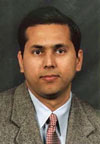 Here is the second myth busted by precision farming specialist Raj Khosla with Colorado State University in CSU’s May-July Agronomy Newsletter.
Here is the second myth busted by precision farming specialist Raj Khosla with Colorado State University in CSU’s May-July Agronomy Newsletter.
 MYTH 2: Precision farming is too difficult to implement
MYTH 2: Precision farming is too difficult to implement
Khosla says it’s not the physical implementation of precision farming that’s difficult, it’s opening one’s mind to change. “There is a steep learning curve with precision farming. But, once in place, precision farming can actually make your farming operation “easier” than it was before adopting it.” Before deciding it is too difficult, he urges farmers to consider the benefits, such as less time in the tractor, lower fuel costs and increased fertilizer-use efficiency.
Every producer knows that the entire field doesn’t yield the same all the way across. There is always that area of the field that just doesn’t yield, no matter how much N and/or water are put on. Agronomists have addressed this and in doing so, have turned traditional wisdom upside down with their unique approach to fertilizer management by viewing each part of the field as a potential investment. Only those areas of the field that are sound investments (i.e., have high productivity potential) receive a high amount of input. In contrast the poor investments (i.e., areas of the field that have a low productivity potential) receive very little, if any input; why invest in something that won’t give you a return? This strategy is known as “site-specific” and has been used widely in conjunction with management zones. The bottom line of this approach is that the total amount of input to be applied to a field is redistributed such that the areas of greatest potential receive the most and visa-versa.
